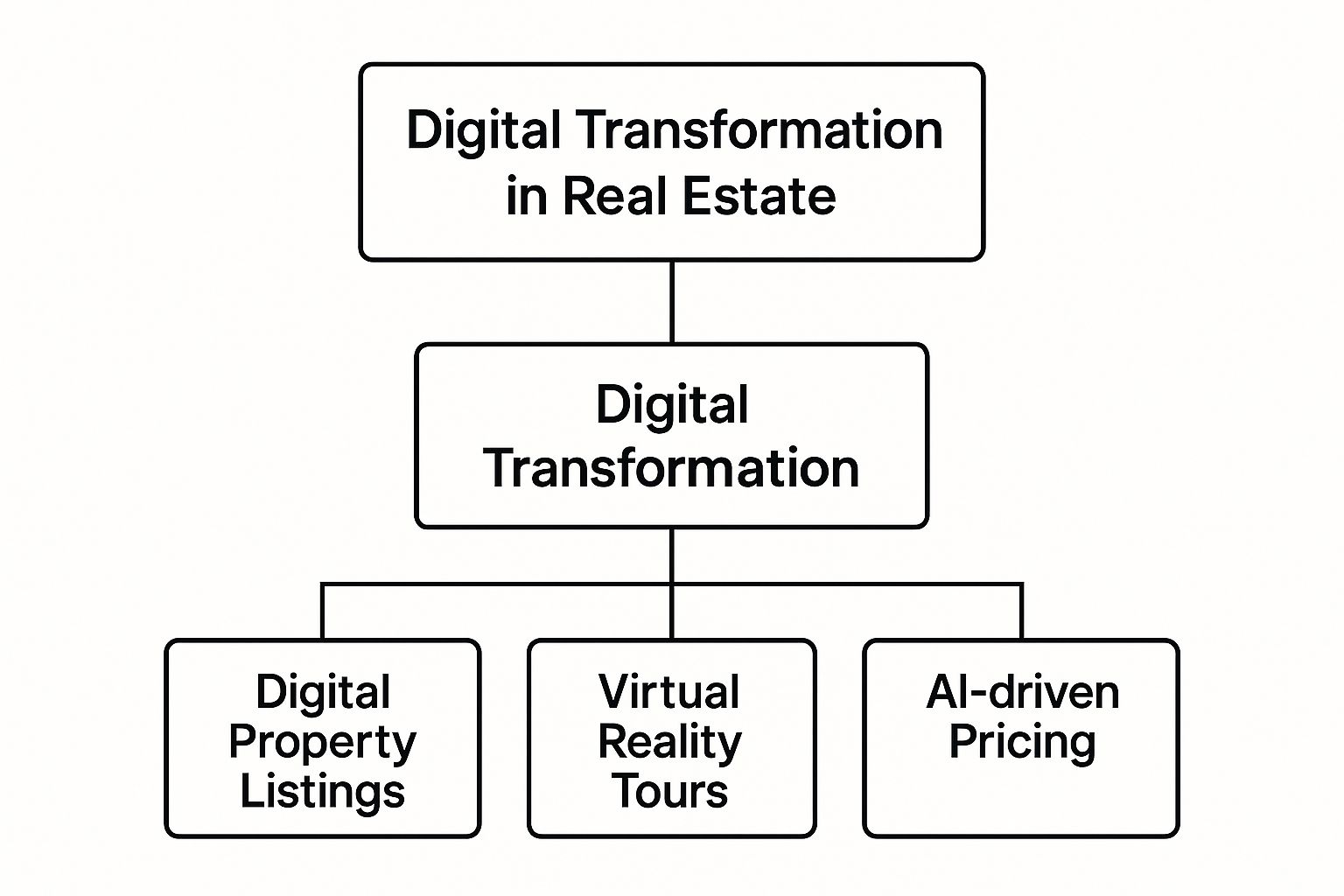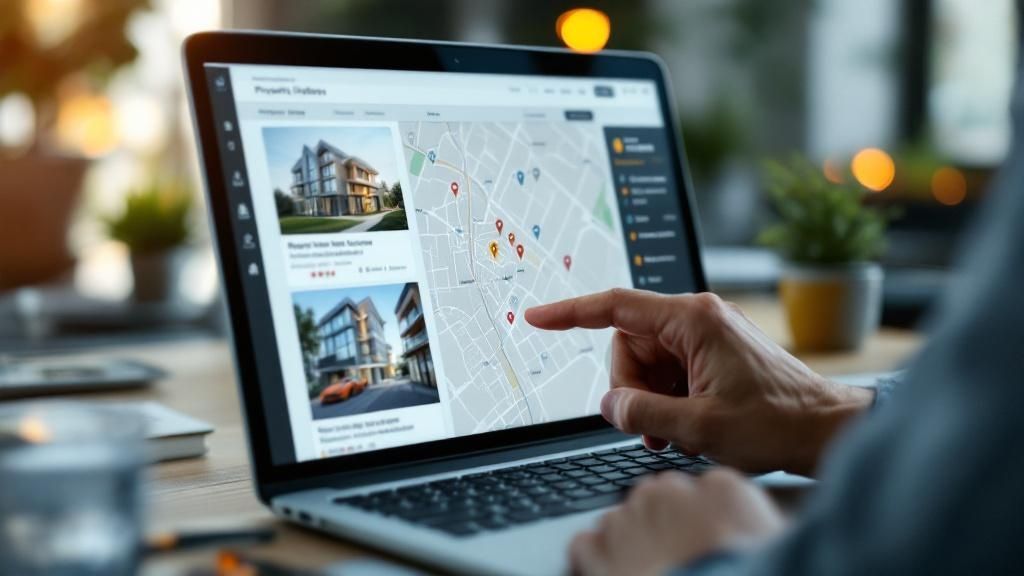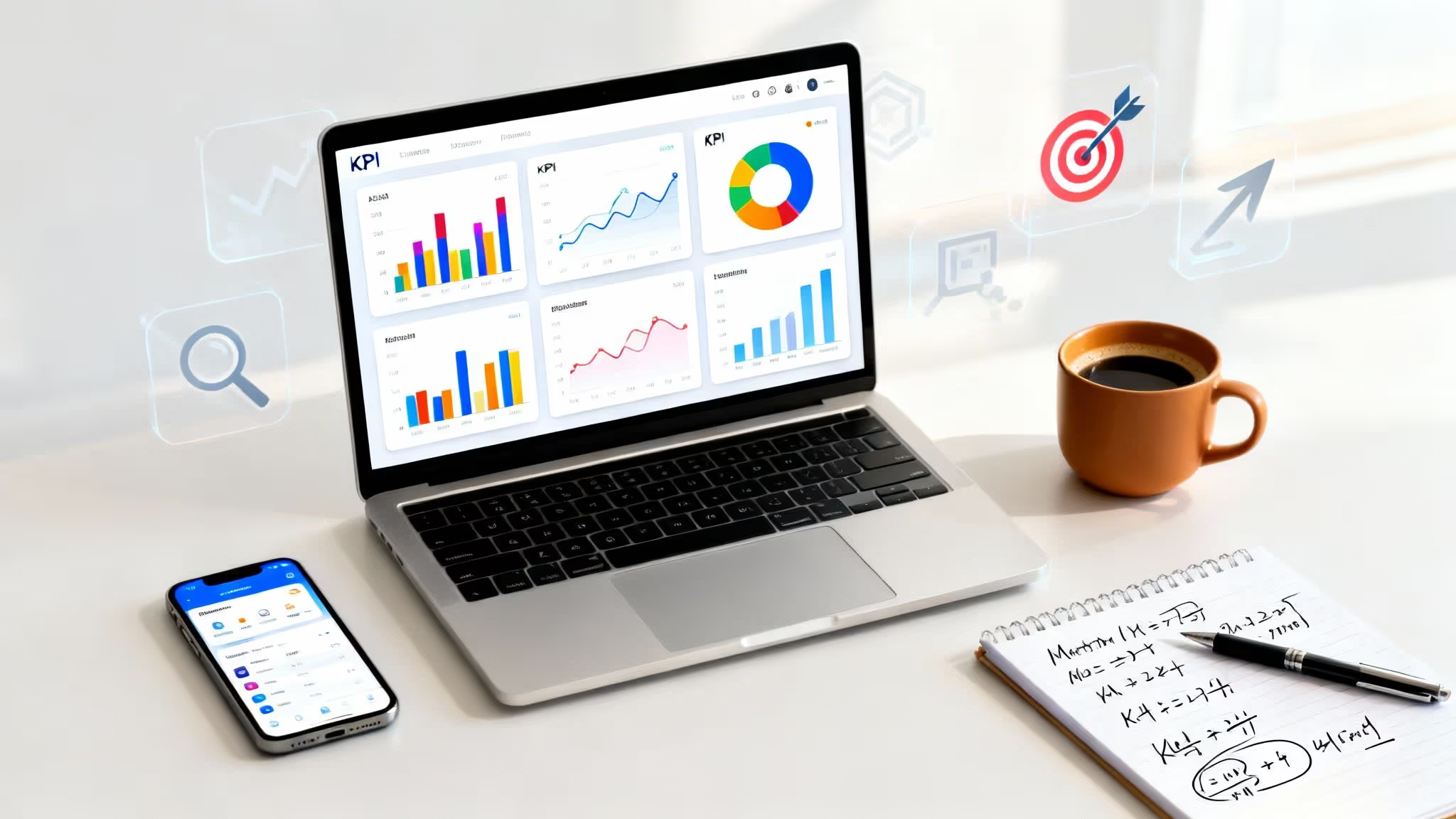Let's move beyond the jargon. Digital transformation in real estate isn't about adopting every new tech trend; it’s a strategic shift in how properties are bought, sold, leased, and managed. It involves integrating technology into the core of your operations to enhance efficiency, enable data-driven decisions, and deliver a superior client experience.
The New Blueprint for Modern Real Estate
Imagine constructing a modern skyscraper. You wouldn't rely solely on concrete and steel; you'd incorporate smart systems for lighting, security, and climate control from the outset. This is an apt analogy for digital transformation in real estate. It's not about adding new software to outdated processes. It’s a strategic overhaul designed to make your business faster, more transparent, and entirely client-centric.
This evolution is no longer optional—it's essential. Today's clients operate in a digital world, expecting instant information, seamless transactions, and on-demand service. The traditional model of waiting for an agent's return call is obsolete in an era where consumers can book travel or order services in seconds from their phones. Technology is the bridge that closes this expectation gap.
The Core Architectural Components
This new digital blueprint is supported by key technological pillars. Consider them not as standalone tools, but as interconnected systems that create a more intelligent and profitable business.
Let's examine the core drivers of this change and their real-world applications.
Table: Core Pillars of Real Estate Digital Transformation
These technologies form the bedrock, transitioning the industry from intuition-based decisions to data-driven strategies and from manual paperwork to automated, secure workflows.
The infographic below illustrates how these high-level concepts translate into practical, high-impact tools that are reshaping the industry.

As you can see, these elements are interconnected. Broad concepts like "AI" become tangible tools such as predictive pricing engines, and "virtualization" manifests as the immersive 3D tours that buyers now expect.
Building a Competitive Edge
When executed correctly, digital transformation provides a powerful competitive advantage. Automating tedious, time-consuming tasks frees up your most valuable resource—your people—to focus on strategy, negotiation, and building strong client relationships.
Furthermore, in today's market, online visibility is paramount. A robust digital foundation is crucial for being seen. To explore this topic further, consult our complete real estate SEO guide to improve search.
By establishing this digital groundwork, you are not just adapting to current trends. You are building a more resilient, efficient, and future-proof business poised for long-term success.
Powering Decisions with Data and AI

For decades, real estate decisions relied on a combination of experience, market knowledge, and intuition. While that expertise remains vital, it is being significantly enhanced. Today, data and Artificial Intelligence (AI) are becoming the central nervous system for modern real estate, transforming intuition into strategies supported by concrete evidence.
This shift is at the heart of the digital transformation in real estate. It represents a move from reacting to market changes to confidently predicting them. Instead of merely analyzing last year's sales figures, firms can now forecast future market behavior with remarkable precision.
From Guesswork to Precision
AI-driven analytics are fundamentally changing how professionals approach everything from investment analysis to property management. These intelligent systems process vast amounts of data—historical prices, demographic shifts, economic reports, and local zoning laws—to identify patterns that would be imperceptible to humans. The result is a more accurate and profitable decision-making process.
This technology helps you identify not just currently popular neighborhoods, but those on the verge of growth. Imagine having an analyst capable of flagging high-potential investment areas before they enter the mainstream and prices escalate. For investors and developers, this predictive capability is a game-changer.
The real breakthrough is providing professionals with the ability to anticipate market movements, evaluate risk more accurately, and offer personalized services at scale. This leads to improved efficiency and a stronger return on investment.
Automating for a Strategic Edge
Beyond strategic planning, AI is a powerful tool for improving day-to-day efficiency. It manages the repetitive, time-consuming tasks that have historically burdened real estate professionals, allowing them to focus on building client relationships and driving strategic growth.
Here’s where AI is already making a significant impact:
- Lease Abstraction: AI tools can scan dense lease documents and extract key data in minutes, a task that previously required hours of meticulous manual work. This reduces errors and helps ensure compliance.
- Predictive Maintenance: For property managers, AI analyzes data from building sensors to predict potential equipment failures. This allows for proactive maintenance, saving money and improving tenant satisfaction.
- 24/7 Client Service: AI-powered chatbots can answer common questions from prospective buyers or tenants around the clock. This provides instant support and qualifies leads, enabling agents to focus on more complex, high-value interactions.
The cumulative effect of this automation is substantial. By 2025, an estimated 89% of real estate executives are expected to rely on analytics for faster, smarter decisions, making data indispensable. AI tools now extend beyond basic automation to predict building failures, quantify investment risks, and personalize the tenant experience. You can learn more about the evolving blueprint for real estate on domain6inc.com.
Unlocking Deeper Market Insights
The true power of AI in real estate lies in its ability to deliver nuanced insights that lead to better outcomes. It's not merely about increasing speed; it's about achieving a fundamentally deeper understanding of the market.
Consider these advanced applications:
- Dynamic Pricing Models: Similar to how airlines adjust ticket prices, AI can help property owners set optimal rental rates or listing prices based on real-time supply, demand, and other local factors.
- Risk Assessment: AI algorithms can analyze hundreds of variables—from economic volatility to environmental reports—to provide a clear, data-driven assessment of an investment's risk.
- Personalized Recommendations: For brokerages, AI can track a client's online behavior and preferences to suggest properties that align with their needs, dramatically improving the likelihood of a successful sale.
By integrating these tools, firms are not just modernizing; they are building a formidable competitive advantage. This intelligent approach to digital transformation in real estate ensures every decision is informed, strategic, and optimized for success.
Building the Future with Smart Properties and IoT

A property was once a static asset. That concept is being completely redefined. Today, the Internet of Things (IoT) is equipping buildings with a digital nervous system, transforming them from passive structures into responsive environments. This is a critical component of the digital transformation in real estate.
A traditional building operates on a preset, inflexible schedule. A smart property, in contrast, is a sophisticated, responsive system. It is equipped with a network of sensors and devices that communicate, gather data, and act on that information to optimize building performance.
The result is a "smart building"—a property that actively reduces its operating costs, improves sustainability, and enhances the experience for its occupants. This is a practical evolution that is making properties more efficient and, consequently, more valuable.
How IoT Makes Buildings Smarter and More Efficient
At its core, IoT in real estate gives buildings operational intelligence. Sensors collect data on everything from room occupancy and air quality to equipment health. This data then powers automated actions that were previously manual or based on a fixed schedule, leading to significant improvements.
Here are a few real-world examples:
- Intelligent HVAC Systems: Traditional HVAC systems run on timers, wasting energy by heating and cooling empty rooms. IoT-powered systems use occupancy sensors to adjust the temperature in real time, providing comfort where needed and savings where possible.
- Predictive Maintenance: Instead of waiting for critical equipment to fail, IoT sensors monitor systems 24/7, detecting early signs of trouble. They can automatically flag an issue for maintenance long before it becomes a costly and disruptive failure.
- Smart Access and Security: Physical keys are being replaced by smartphone-based access. This is more convenient for tenants and provides property managers with a real-time log of entries, enhancing building security.
The key benefit of IoT is twofold: it reduces operational costs for owners while creating a safer, more convenient, and personalized experience for tenants. This powerful combination boosts both asset value and tenant loyalty.
The Real-World Payoff for Owners and Tenants
The impact of IoT extends beyond novel technology. For property owners and managers, the financial and operational benefits are significant. Automated systems reduce manual labor, predictive maintenance prevents expensive emergency repairs, and optimized energy use lowers utility bills.
For building occupants, the benefits are experiential. An office where lighting adjusts to the time of day to improve focus, or an apartment that learns a resident's daily routine and preferred temperature, are examples of features that differentiate a property, improve tenant retention, and attract new occupants.
A New Standard for Property Value
Ultimately, IoT integration is setting a new standard for what defines a premium property. A building’s value is no longer determined solely by its location and size. Its "IQ"—its smart capabilities—is rapidly becoming a crucial factor.
This shift is central to the digital transformation in real estate. Properties that are more efficient, sustainable, and responsive to human needs are inherently more valuable. As this technology becomes the industry standard, buildings without these intelligent features risk being left behind. IoT is not just an upgrade; it is an essential investment for any future-proof real estate asset.
Rethinking Property Ownership with Blockchain
Beyond smart buildings and data analytics, one of the most profound outcomes of the digital transformation in real estate is a change to the fundamental concept of property ownership. Real estate has traditionally been an illiquid asset—difficult to buy, slow to sell, and nearly impossible to divide. Blockchain technology is challenging that old model, creating entirely new ways to own, trade, and manage property.
At the heart of this shift are two interconnected concepts: tokenization and smart contracts. Together, they are establishing the foundation for a real estate market that is more efficient, transparent, and accessible to a broader range of investors.
Making Real Estate Liquid Through Tokenization
Consider a high-value commercial building. Traditionally, acquiring a stake in such an asset required significant capital, excluding most individual investors. Tokenization changes this dynamic completely.
By way of analogy, imagine a valuable painting. Instead of one person owning the entire piece, it could be digitally divided into thousands of "shares," or tokens, each representing a verifiable fraction of ownership. This would allow individuals to buy a small stake, trade it with others, and benefit from its appreciation.
Tokenization applies this same principle to real estate. A property's ownership is digitally represented on a blockchain and divided into secure tokens that can be bought and sold.
This introduces unprecedented liquidity to a historically illiquid asset class. It allows owners to liquidate a portion of their equity without selling the entire property and enables smaller investors to participate in high-value deals that were previously inaccessible.
Automating Trust with Smart Contracts
If tokenization defines what is owned, smart contracts define how it is transacted. A smart contract is a self-executing agreement with its terms written directly into code on a blockchain. It automatically enforces the rules and executes the transaction once predetermined conditions are met.
Contrast this with the traditional closing process, a lengthy and complex procedure involving lawyers, escrow agents, banks, and extensive paperwork. Each step introduces potential for delays, costs, and human error.
A smart contract automates this entire process. For example, upon verification of the buyer’s funds and the digital title, the contract can instantly transfer payment to the seller and the title to the buyer. The contract itself acts as a trusted, automated intermediary.
Smart contracts are the engine making blockchain-based real estate both efficient and secure. They reduce the need for expensive middlemen, shorten transaction times, and create a permanent, immutable record of every step, dramatically minimizing the risk of fraud.
This is a fundamental change to how property is transacted. In some markets, the combination of tokenization and smart contracts is already reducing closing times from weeks to hours. The transparency of an immutable ledger builds trust directly into the system. You can find out more about how technology is disrupting the market from data and news at Datacenters.com.
The New Marketplace in Action
This is not a futuristic concept; platforms are already making it a reality. Investors can now browse tokenized properties online, purchase fractional ownership with a few clicks, and manage their real estate holdings as easily as a stock portfolio. The impact of this digital transformation in real estate is significant:
- Global Access: An investor in Tokyo can purchase a share of a building in New York without navigating complex cross-border legal frameworks.
- Reduced Costs: Fewer intermediaries and less manual paperwork result in lower transaction fees for all parties.
- Enhanced Transparency: Every transaction is recorded on the blockchain, creating a clear and tamper-proof ownership history.
By rethinking how ownership is defined and transferred, blockchain is laying the groundwork for a more democratic, efficient, and secure global real estate market.
Gaining an Edge with Big Data Analytics
If AI is the engine and IoT is the fuel, then Big Data analytics is the GPS providing the strategic roadmap. This isn't just about reviewing past sales or current listings. It’s about synthesizing massive, seemingly unrelated streams of information to move from reacting to the market to anticipating it.
Imagine combining census data on population shifts with city traffic patterns, new business permits, and long-term economic forecasts. The most innovative firms are doing just this—creating a unified picture from siloed information. This comprehensive view provides a significant advantage in the ongoing digital transformation in real estate.
Uncovering Hidden Opportunities
Think of big data analytics as a high-powered telescope for identifying future trends before they become obvious. It allows investors and developers to pinpoint the next growth area well before property values begin to climb. By analyzing subtle signals hidden within the data, you can make smarter, more confident decisions on where to build or buy.
This level of insight helps answer critical questions that were once based on intuition:
- Which neighborhoods show early signs of gentrification over the next five years?
- Where are planned infrastructure projects most likely to boost property values?
- What specific amenities are renters genuinely seeking in this submarket?
Armed with these answers, you can refine development plans and allocate capital where it will have the greatest impact. It also allows for highly targeted marketing. For insights on maximizing your advertising budget, our guide on winning with real estate PPC advertising offers effective strategies.
The fundamental change is shifting from analyzing what happened to predicting what will happen. This forward-looking strategy, powered by deep data insights, is how you navigate a complex market and maintain a competitive edge.
Data-Driven Investment Confidence
Ultimately, the power of big data is about minimizing risk and guesswork. With the global market for big data analytics expected to surpass $68 billion by 2025, it's clear the real estate sector is fully committed. Firms are using sophisticated data to evaluate a property's potential, weigh risks, and forecast returns with much greater accuracy.
Machine learning models can now process everything from foot traffic data and demographic reports to a building's specific attributes, giving investors validated reasons to move forward. This data-first approach transforms the entire investment journey. From site selection and due diligence to portfolio management and exit strategy planning, analytics provide the intelligence needed to make optimal decisions. In an industry where timing is critical, using big data is the new benchmark for success.
Your Digital Transformation Roadmap

Embarking on a digital transformation can feel like planning a complex journey. The key is not to attempt everything at once, but to chart a clear, phased course that leads to your destination efficiently.
The first and most critical step is a candid assessment of your current state. Analyze your day-to-day operations. How do you manage leads? What are your client communication protocols? How are transactions handled? Identifying bottlenecks and time-consuming, repetitive tasks is your starting point. These are the areas where technology can deliver the most significant and immediate returns.
Fostering a Culture of Innovation
Even the best technology is ineffective without the right people and culture to support it. A culture that embraces innovation is the engine that will power your entire digital transformation in real estate. This must begin with leadership, who should not only approve budgets but also actively champion the change.
However, adoption cannot be a top-down mandate alone. Involve your team from the beginning. Engage with agents, property managers, and support staff. Ask them: "What is the most frustrating part of your workday?" When your team sees that new technology is chosen to solve their problems, they transition from being resistant to becoming your strongest advocates.
A successful transformation is built on demonstrating value early and often. Don't attempt to implement everything at once. Instead, launch small, manageable pilot projects focused on solving one or two key pain points. The ROI from these early wins provides a compelling business case for scaling your efforts across the organization.
Planning a Phased and Strategic Rollout
With priorities established and your team engaged, it's time to map out the implementation. The key is to think in phases. A gradual rollout minimizes disruption, reduces stress, and gives everyone time to adapt to new processes.
Here’s a practical sequence that has proven effective:
- Choose the Right Partners: You are a real estate expert, not necessarily a technology specialist. Find technology vendors or agency partners who understand the real estate industry and can provide expert guidance.
- Start with a Pilot Project: Select a small, motivated group to test a new tool, such as a modern CRM or a transaction management system. Your goal is to measure the real-world impact on their efficiency and client satisfaction.
- Gather Feedback and Iterate: Use feedback from your pilot team to refine the implementation. Identify what worked and what was cumbersome. This feedback loop is essential for success.
- Scale What Works: Once you have solid results and positive testimonials from your pilot group, you have the justification needed to confidently roll out the solution to the rest of the company.
This deliberate approach breaks a large initiative into a series of achievable wins. Many of these principles apply beyond real estate. For a broader perspective, explore our insights on digital transformation for professional services. By following a structured path, you can turn a complex challenge into a successful reality.
Frequently Asked Questions
Integrating new technology into a real estate business raises important questions about where to begin, the associated costs, and how to ensure team adoption. Let's address some of the most common concerns.
Where Should a Small Real Estate Agency Start?
For smaller agencies, it is best to focus on one high-impact area to achieve a quick, tangible win. This builds momentum and validates the approach.
A modern Customer Relationship Management (CRM) system is an excellent starting point. A quality CRM will immediately organize lead and client information, automate follow-ups, and provide a clear overview of your sales pipeline. Another effective first step is adopting a digital transaction management tool to eliminate excessive paperwork. Neither requires a massive budget, but both deliver immediate, noticeable improvements in efficiency.
Is Digital Transformation Too Expensive for My Business?
The cost of a digital transformation in real estate can be managed by being strategic and rolling out initiatives in phases that align with your budget. It does not have to be a prohibitive expense.
Many of the best tools today are cloud-based platforms offered on a subscription basis (SaaS, or Software-as-a-Service), which avoids large upfront capital investments. Instead of attempting a complete overhaul at once, you can begin with a single, affordable pilot project.
Start by selecting a project that solves a persistent pain point. Once you can demonstrate a clear Return on Investment (ROI)—such as hours saved per week or deals closing faster—it becomes much easier to justify further investment.
The cost of inaction is often much higher. Inefficient processes lead to lost time, missed opportunities, and the risk of being outpaced by more agile competitors.
How Do I Get My Team On Board with New Technologies?
A tool's effectiveness depends entirely on user adoption. Gaining your team's support begins with clearly communicating the "why."
Position new software not as a complex task to be learned, but as a tool that will make their jobs easier and help them succeed. Demonstrate how a CRM can automate routine follow-ups, freeing them to engage directly with clients. Explain how data can help identify better leads, which translates directly to more commissions.
The following tactics are consistently effective:
- Involve Them Early: Invite key agents and staff to participate in vetting and testing new software. When they have a voice in the decision, they feel a sense of ownership.
- Invest in Proper Training: Provide structured training sessions that demonstrate not just the technical "how-to," but also the strategic "why" behind the new tool.
- Highlight Successes: When a new tool contributes to closing a deal faster or earning a positive client review, celebrate that success publicly. Success is contagious and builds genuine enthusiasm for the broader digital transformation in real estate journey.
Ready to turn these insights into action? Twelverays specializes in helping real estate businesses implement data-driven strategies and CRM solutions that drive real growth. Let's build your success plan together. Find out how we can help.





